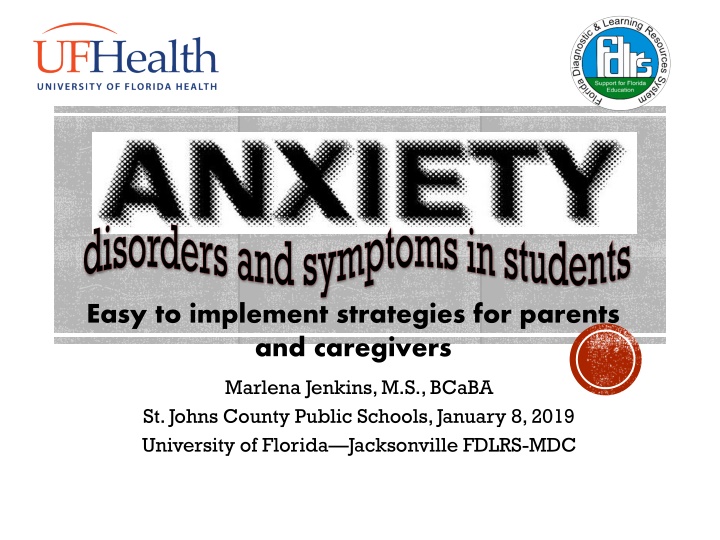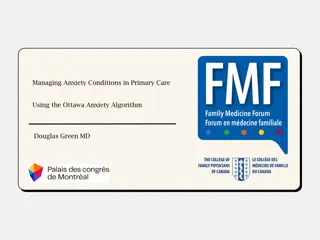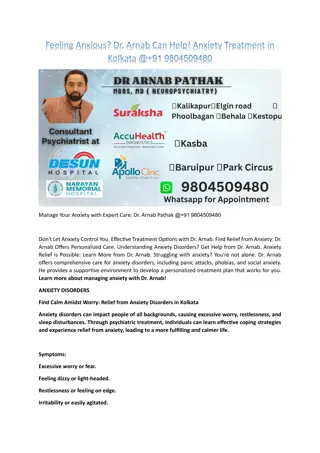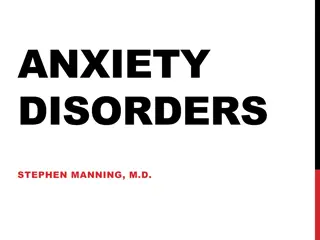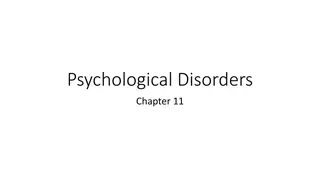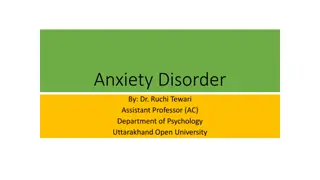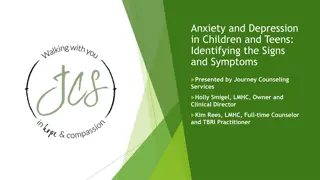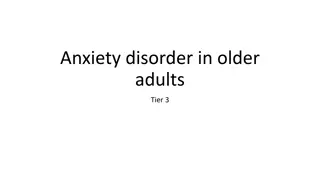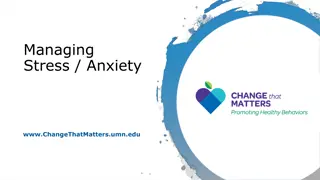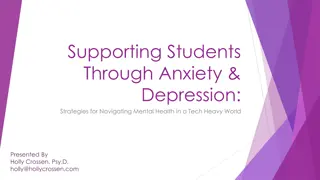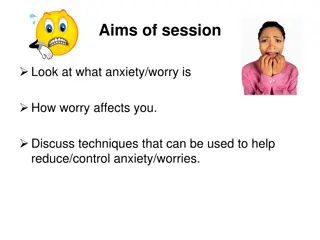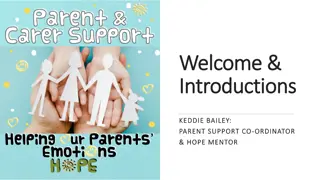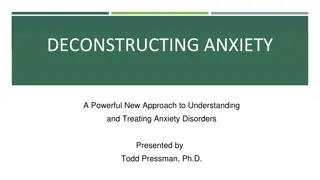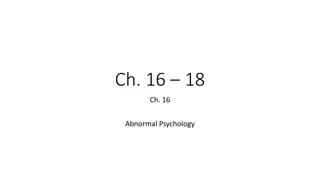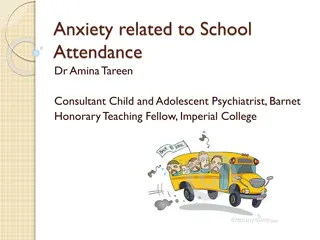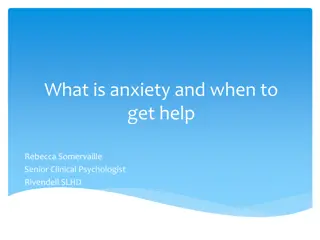Anxiety Symptoms and Disorders in Students
Strategies for parents and caregivers to implement when dealing with anxiety-related symptoms in students, including types of anxiety, making referrals, and understanding behavioral manifestations.
Download Presentation

Please find below an Image/Link to download the presentation.
The content on the website is provided AS IS for your information and personal use only. It may not be sold, licensed, or shared on other websites without obtaining consent from the author.If you encounter any issues during the download, it is possible that the publisher has removed the file from their server.
You are allowed to download the files provided on this website for personal or commercial use, subject to the condition that they are used lawfully. All files are the property of their respective owners.
The content on the website is provided AS IS for your information and personal use only. It may not be sold, licensed, or shared on other websites without obtaining consent from the author.
E N D
Presentation Transcript
isorders and symptoms in students Easy to implement strategies for parents and caregivers Marlena Jenkins, M.S., BCaBA St. Johns County Public Schools, January 8, 2019 University of Florida Jacksonville FDLRS-MDC
UF HEALTH DEVELOPMENTAL PEDIATRIC CENTER Grant-Funded Insurance-Based Self-Pay Pediatric Assessment and Intervention Program (PAIP) Center for Autism and Related Disabilities (CARD) Dr. Childers Jeannie Potthast Elise Summa Various Providers Works with children and adults with an autism spectrum disorder, dual sensory impairment or sensory impairment combined with another disabling condition. Florida Diagnostic Learning and Resource System Multidisciplinary Center (FDLRS) Developmental Pediatrics Neurology Dr. Childers Dr. Dial Marlena Jenkins Various Providers Marlena Jenkins Various Providers Psychoeducational, psychological, speech and/or language, and neurodevelopmental evaluations for children 3 to 22 years, providing they are still in high school, who are struggling in school due to complicated medical, behavioral, developmental and/or social histories. Dr. Tardo Neurodevelopmental pediatrician Child Neurology Educational Assessment Our child neurology services include Cerebral Palsy; Neurodegenerative conditions; Neuromuscular conditions; Hypotonia; Premature follow- up; Autistic Disorders; Developmental Delays; Headaches and Movement Disorders Educational / Behavioral Consultations This division brings together various specialists to work with children at risk for learning, behavioral or developmental delays. They serve children with a variety of disorders, ranging from developmental delays that may be overcome with early care and treatment to lifelong conditions that may be alleviated with ongoing support and appropriate care regimens. Food Over-Selectivity Clinic Intensive Academic Intervention Parent and teacher consultation and training. Targeted Parent Training Serving families in Duval, Clay, St. johns, Nassau, Baker and Flagler counties Serving families in Duval, Clay, St. Johns, Nassau, Baker and Flagler counties. Adaptive / Behavior Clinic Study and Organizational Strategies Thematic Social Skills Groups
TRAINING AGENDA Defining anxiety Types of anxiety and related disorders Anxiety related symptoms across childhood and adolescence Making referrals Strategies Questions When you see this image Think deeper about the concept
WHAT IS ANXIETY? a feeling of worry, nervousness, or unease, typically about an imminent event or something with an uncertain outcome. desire to do something, typically accompanied by unease. What does the uncertainty of outcomes have to do with anxiety related symptoms If there is a desire to do something why are behavioral manifestations of anxiety labeled as noncompliance
ANXIETY DISORDERS -THE STATS- #1 mental health disorder in America Only 1 in 5 teenagers receive treatment what are the barriers Today s pressures trigger anxiety further are the triggers within our control Must cause clinically significant distress or impairment in social, academic, occupational, or other important areas of functioning to meet diagnosis. The symptoms cannot be better accounted for by another mental disorder or be caused by substances, medications, or medical illness.
SEPARATION ANXIETY DISORDER -CLINICAL DESCRIPTION- Developmentally inappropriate and excessive fear or anxiety concerning separation from those to whom the individual is attached. Symptoms last at least 4 weeks in children and adolescents. -symptoms- Recurrent excessive distress when separation from home or major attachment figures occurs (or is anticipated) Persistent and excessive worry that something traumatic will lead to separation from a major attachment figure (e.g., being kidnapped) Persistent reluctance or refusal to go to school or other places because of fear of separation Persistent or excessive fear or reluctance to be alone or without major attachment figures at home or in other settings Persistent reluctance or refusal to go to sleep without being near a near a major attachment figure (or to sleep away from home) Repeated complaints of physical symptoms (e.g. headaches, stomachaches, vomiting) when separated from major attachment figures (or separation is anticipated)
GENERALIZED ANXIETY DISORDER -CLINICAL DESCRIPTION- Excessive anxiety and worry about a variety of events or activities, even when nothing is wrong or when the worry is disproportionate to actual risk. The worry is difficult to control. Symptoms last at least 6 months. -symptoms- The worry is associated with at least three (in adults) or one (in children) of the following physical or cognitive symptoms: Restlessness Fatigue Impaired concentration or feeling that mind is going blank Irritability Increased muscle aches or soreness Difficulty sleeping (trouble falling asleep or staying asleep) Sometimes associated with other physical symptoms such as nausea or diarrhea.
SPECIFIC PHOBIAS -CLINICAL DESCRIPTION- Marked and persistent fear that is excessive or unreasonable, cued by the presence or anticipation of a specific object or situation. The phobic object/situation is actively avoided or endured with intense fear or distress. Will almost always provoke an immediate anxiety response Fear is recognized as being excessive or unreasonable. Symptoms last at least 6 months.
SPECIFIC PHOBIAS -GENDER DIFFERENCES Boys Fears Free Option Spiders Predators Being hit by a car Snakes Burglar Frightening movies The dark Being teased Frightening dreams Medical operations Girls Fears Free Option Spiders Being kidnapped Parents dying The dark Frightening movies Thunderstorms Being teased Bats Bats/ghosts/spooky things Sleeping in the dark/Making a mistake Source: Muris, P., Merckelbach, H., & Collaris, R. (1997). Common childhood fears and their origins. Behavior Research and Therapy, 35(10), 929-937
OBSESSIVE-COMPULSIVE DISORDER Characterized by obsessive, intrusive thoughts (e.g. constantly worrying about staying clean, or about one's body size) that trigger related, compulsive behaviors (e.g. repeated hand- washing, or excessive exercise). These behaviors are performed to alleviate the anxiety associated with the obsessive thoughts. Obsessions/compulsions interfere with social or work interactions. The symptoms are not triggered by a) the physiological effects of a substance (i.e. drugs or alcohol) or b) another medical condition (e.g., excoriation or hoarding).
OBSESSIONS AND COMPULSIONS Obsessions: Recurrent & persistent thoughts/urges/images that are experienced as intrusive & unwanted Individual attempts to ignore or suppress thoughts/urges/images, or tries to neutralize them with some other thought or action (i.e., performing a compulsion) Compulsions: Repetitive behaviors (e.g., hand washing, ordering, checking) or mental acts (e.g., counting, repeating words silently) that individual feels driven to perform in response to an obsession or according to rules that must be applied rigidly. Behaviors or mental acts are aimed at preventing/reducing anxiety/distress, or preventing some dreaded event/situation. Obsessions or compulsions are time-consuming (e.g., take >1 hour/day) or cause distress/impairment in functioning
PANIC DISORDER Recurrent expected or unexpected panic attacks AND one or more of the following symptoms for at least one month: Pounding heart Sweatiness Feeling of weakness Faintness Dizziness Tingling or numbness in hands Feeling flushed Sense of unreality Feeling of loss of control or losing one's mind Fear of dying or something physically wrong (e.g., heart attack, stroke) At least 1 of the attacks has been followed by 1 month (or more) of one or both of the following: Persistent concern or worry about future/additional panic attacks or their consequences A significant change in behavior related to the attacks (e.g., behaviors designed to avoid panic attacks)
SOCIAL ANXIETY DISORDER -CLINICAL DEFINITION- Marked fear or anxiety about 1 or more social situations in which the individual is exposed to possible scrutiny (embarrassment or criticism) by others. The individual fears that he or she will act in a way or show anxiety symptoms that will be negatively evaluated. The social situations almost always provoke fear or anxiety. Symptoms last at least 6 months in children and adolescents. Generalized fear is present across any social situations Specific eating in public, public speaking, talking with certain roles
SOCIAL ANXIETY DISORDER -SYMPTOMS- Significant and persistent fear of one (or more) social or performance situations in which the individual is exposed to unfamiliar people, or to possible scrutiny by others due to fear of humiliation or embarrassment. Note: In children, the anxiety must be present in peer situations and not only in interactions with adults. Exposure to the feared social or performance situation provokes significant anxiety. The person recognizes that the fear is excessive or unreasonable. why does development matter The feared social or performance situations are avoided or else are endured with intense anxiety or distress
SELECTIVE MUTISM -CLINICAL DEFINITION- Consistent failure to speak in specific social situations in which there is an expectation for speaking (e.g., at school) despite speaking in other situations. The failure to speak is not attributable to a lack of knowledge of, or comfort with, the spoken language required in the social situation. The duration is at least 1 month. Symptoms cannot be better accounted for by another mental disorder or be caused by substances, medications, or medical illness.
ANXIETY ACROSS THE AGES -CHILDHOOD-
ANXIETY ACROSS THE AGES -CHILDHOOD & ADOLESCENCE-
IS IT TIME TO BE CONCERNED? Worry that lasts for months Worry that causes physical distress Refuses to go to school or participate in activities Trouble concentrating in class Seems unusually gloomy/pessimistic Asks for a lot of reassurances Becomes upset if reassurances are considered inadequate Seems irritable & angry Sleep deprivation Is excessively self-critical Suicidal ideation Self-harm Fears are significantly interfering with your family, educational, work, daily life
RESTRUCTURING THOUGHTS Anxious Thought Evidence that thought is TRUE Evidence that thought is FALSE New Thought The storm might cause lightning to strike our school and hurt me. Lightning can strike buildings. Chances are lightning won t strike our school. Even if lightning strikes the building, I will remain safe. Lightning can strike people who are not under shelter. The school is built to handle storms and keep people safe. If lightning strikes the school, the roof will protect me. * I will follow the emergency plan. IF the roof catches on fire, I will evacuate *I have an emergency plan.
QUESTIONS TO ASK -FALSE THOUGHTS- Do I know for sure that ______ will happen? What evidence do I have that _______ will happen? How likely is it really? Has _______ ever happened before? Even if _______ happens, can I live through it? What is the worst possible outcome? (Rate how bad it is) Could I cope? Do I have the coping mechanisms or do I need help? Do I know anyone else who has been in this situation? What did they do? Have I been able to cope with ______ in the past?
SONOW WHAT DO WE DO? Define the behavioral manifestation and Collect data Step 1 if the effects of anxiety related symptoms are impacting the student s learning and school based relationships Observable and Measureable Peer Modeling (select a peer that is similar to the target child/teen) Arrange for frequent learning opportunities and taper off over time Use pivoting technique in the natural environment Maintain open lines of communication Develop a plan and stick to the script Practice, practice, practice Never use the child/teen s fear during times of discipline
TARGETING PHYSICAL FEELINGS Slow breathing Deep abdominal breathing Body scan Imagery breathing Quick 5-4-3-2-1 Grounding Activity
BRAVERY LADDER Hardest behavior at top, easiest behavior at bottom Take (emotional, physiological) temperature along way Earn Bravery Dollars Use labeled praise
IN SCHOOL -SOCIAL SITUATIONS- [Hardest] I went to the lunchroom and sat at a table with some kids I know and joined a conversation. 1. I went to the lunchroom and sat at a table with some kids I know. 2. I started a conversation with somebody in my class. 3. I said hi to a kid in my class who I usually don t talk to, even though he didn t say hi first. 4. I tried to speak up more loudly when I answered a question in class. 5. I answered a question in class when the teacher called on me. It was a question that she did not prepare me for answering ahead of time. 6. I answered a question in class when the teacher called on me. It was a question she prepared me for answering ahead of time. 7. I remembered to face somebody I was talking to and not turn in the other direction. 8. [Easiest] I practiced making eye contact with the teacher when she was talking to me. 9.
GOING TO SCHOOL [Hardest] I left for school on time, had no reminders, and I entered the school building all by myself with no fussing. I changed my worry thoughts and noticed that I can still go to school even when I am anxious about it. 1. I did number 3 on ladder and got to school on time. 2. I did number 4, but this time I walked into school by myself, not with my parents. 3. I accomplished all of the things on my morning routine with 1 or no reminders and got into the car without any fussing or fighting. 4. I was able to change my worry thoughts when I felt anxious this morning and then did 2 of the things on my morning routine with only 1 reminder. 5. I woke up on time and also did 1 of the things on my morning routine with only 1 reminder from my parents. 6. [Easiest] I woke up on time this morning. 7.
COPING CARDS Palm-sized, colorful cards that have pre-printed positive "self- statements" that have been designed specifically for children. Children can read the statements on the cards anytime, and can store them easily in a backpack or pocket for quick, easy reminders of their ability to cope with whatever comes their way. Coping Cards include several blank cards in addition to the pre-printed cards for your child to personally tailor specific cards to his or her fears or concerns. Appropriate for children between the ages of approximately 5- 14 years, Coping Cards are a great tool for boosting youngsters' confidence in their ability to cope with stress and anxiety. Donna Pincus, Ph.D., The Child Anxiety Network, 2001
BEHAVIORAL APPROACH -WHAT IS THE FUNCTION- Any technique or process that is meant to alter a dimension or the effects of behavior. Examples of behavioral strategies are planned ignoring, redirection, reinforcement, and punishment, etc. Function based Escape/Avoidance: to get away from or eliminate contact with something, some place, or someone Access: to gain initial or more access to something, some place, or someone Automatic: internally driven desire to fulfill a need (measured by the student himself) Attention Maintained: meant to gain initial or continued access to attention from something in the environment Power/Control: desire to have things my way or to overpower something in the environment
CHANGING BEHAVIOR Punishment Reinforcement Positive and Negative Positive and Negative Decreases the likelihood that the behavior will occur again Increases the likelihood that the behavior will occur again BEHAVIORAL APPROACH Although you have a functionally equivalent replacement behavior you may have missed the anxiety provoking trigger. SHAPE up the target behavior Reinforcement small steps moving toward the larger goal/behavior
POST - CRISIS Reflective journaling Written, drawing or audio recording Buddy check time (using peer model) Self evaluation (rating scale) How well did I use the rehearsed coping skills? Was I more or less independent than the last time? Gratitude journal Puts negative thoughts in perspective A nap Some panic attacks can be so physically and mentally exhausting that a little rest is needed Monitor for escape or avoidance based behaviors
DO DON T It s okay to allow your student to experience anxiety-provoking situations Bend over backwards to avoid anxiety-provoking situations Minimize your student s feelings or tell them how they should feel instead Validate your student s feelings Encourage your student to BE BRAVE! and/or to BEAT THE WORRY MONSTER! Overly reassure your student or try to remove your student from the anxious situation
IT TAKES A VILLAGE -BUT LET S START WITH YOU- Select an accountability partner. Someone the child/teen is comfortable talking with in an open fashion. Discuss strengths and weaknesses Assist with advocating on behalf of the child/teen Available to talk through ideas, trouble shoot and provide feedback on progress/regression Responsible for helping to redirect the child/teen back to the task at hand. Responsible for verbally and tangibly reinforcing the child/teen. Someone who is easily accessible.
SEEKING PROFESSIONAL HELP Cognitive-Behavioral Therapy (CBT) Consult with your child s/adolescent s PCP https://www.clinicalchildpsychology.org/ Society of Clinical Child and Adolescent Psychology (online presentations by psychologists) http://www.adaa.org/ Anxiety and Depression Association of America www.childanxiety.net Child Anxiety Network
REFERENCES & RECOMMENDED READING Pincus, D. B. (2012). Growing Up Brave: Expert Strategies for Helping Your Child Overcome Fear, Stress, and Anxiety. Little, Brown, and Company, New York, NY. Resources and exercises/toolkits for home and school: Anxiety BC: www.AnxietyBC.com https://www.youtube.com/watch?v=r_5eiYIo1XM WayAhead: Mental Health Association NSW: www.WayAhead.org.au Rethinking Thinking Trevor Maber (TED ED): https://youtu.be/KJLqOclPqis Children s Fears: Developmental or Disorder?: What Educators Should Know Sacha N. Matthews University of Pittsburgh, School of Educational, 2010 Gratitude Journal: www.Amazon.com various religious and non-religious themed journals www.Therapistaid.com www.Merakilane.com www.thechaosandtheclutter.com www.gozen.com
What are your final questions, deeper take away thoughts and things to continue working through in the days or months ahead? Feel free to contact our UF JAX FDLRS-MDC for continued conversation or to schedule consultative support! Marlena Jenkins, M.S., BCaBA Marlena.Jenkins@jax.ufl.edu 904-633-4332
